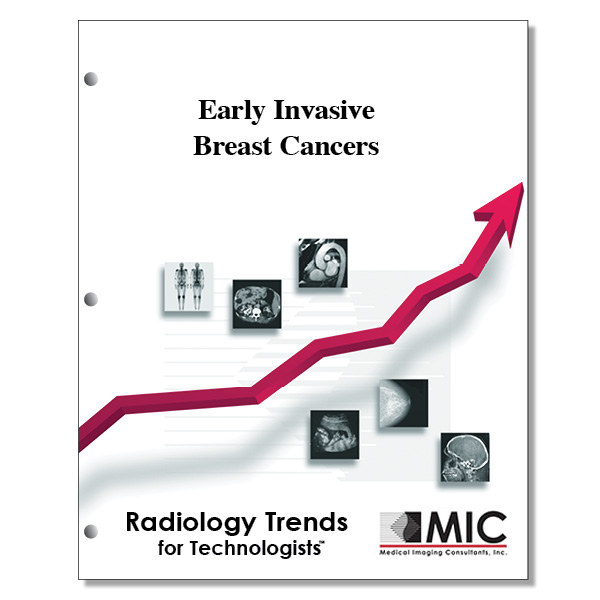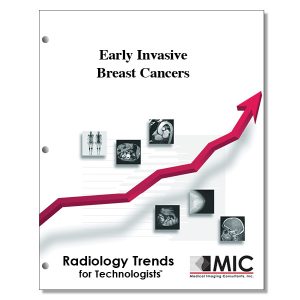

Early Invasive Breast Cancers
A practical approach to the detection and management of breast masses and asymmetries for the early detection of breast cancer.
Course ID: Q00298 Category: Radiology Trends for Technologists Modalities: Mammography, Nuclear Medicine, Sonography2.25 |
Satisfaction Guarantee |
$24.00
- Targeted CE
- Outline
- Objectives
Targeted CE per ARRT’s Discipline, Category, and Subcategory classification for enrollments starting after February 8, 2023:
[Note: Discipline-specific Targeted CE credits may be less than the total Category A credits approved for this course.]
Breast Sonography: 2.25
Patient Care: 0.50
Patient Interactions and Management: 0.50
Image Production: 0.50
Evaluation and Selection of Representative Images: 0.50
Procedures: 1.25
Anatomy and Physiology: 0.25
Pathology: 0.75
Breast Interventions: 0.25
Mammography: 2.25
Patient Care: 0.25
Patient Interactions and Management: 0.25
Image Production: 0.25
Image Acquisition and Quality Assurance: 0.25
Procedures: 1.75
Anatomy, Physiology, and Pathology: 1.00
Mammographic Positioning, Special Needs, and Imaging Procedures: 0.75
Magnetic Resonance Imaging: 1.50
Patient Care: 0.25
Patient Interactions and Management: 0.25
Procedures: 1.25
Body: 1.25
Nuclear Medicine Technology: 1.50
Patient Care: 0.25
Patient Interactions and Management: 0.25
Procedures: 1.25
Endocrine and Oncology Procedures: 1.25
Registered Radiologist Assistant: 2.25
Procedures: 2.25
Thoracic Section: 2.25
Sonography: 1.50
Patient Care: 0.25
Patient Interactions and Management: 0.25
Procedures: 1.25
Superficial Structures and Other Sonographic Procedures: 1.25
Radiation Therapy: 2.25
Patient Care: 1.00
Patient and Medical Record Management: 1.00
Procedures: 1.25
Treatment Sites and Tumors: 1.25
Outline
- Introduction
- An Approach to Detecting Masses and Focal Asymmetries at Screening Mammography
- Asymmetric Breast Tissue versus Focal Asymmetry
- Detecting Focal Asymmetries
- Evaluating a Mass or Focal Asymmetry Identified at Screening
- Diagnostic Evaluation of Masses and Focal Asymmetries
- Management of Breast Masses and Focal Asymmetries
- The Worst Feature Wins
- Malignant Features
- Benign Features
- Probably Benign
- Summary
Objectives
Upon completion of this course, students will:
- identify how invasive breast cancer will appear on a mammogram
- understand why early detection of a mass or asymmetry is important
- identify survival rates for women with invasive breast carcinoma
- define a mass according to the BI-RADS reporting system
- define a focal asymmetry according to the BI-RADS reporting system
- identify the most common type of breast cancer
- learn the most efficient way to interpret mammograms
- list the required views for a screening mammogram
- explain why global asymmetry is of concern
- state the percentage of all cancers that are invasive lobular carcinomas
- explain how invasive lobular carcinoma spreads
- describe how cancer will manifest in dense breast tissue
- identify a positional necessity to image the retroareolar region
- know the importance of the appearance of Cooper’s Ligaments
- list which masses are typically benign
- understand why a typically benign mass may not be benign
- explain which interpretation practices can improve sensitivity
- identify the next step in patient care after identifying a mass or asymmetry at screening mammography
- list the reasons for additional imaging
- identify the views required during recall examinations
- name the views for lateral projections
- list the views helpful in localizing a lesion
- identify another modality helpful in confirming a focal asymmetry
- identify views helpful in finding a lesion only seen on a CC view
- identify views helpful in finding a lesion only seen on a MLO view
- describe how lesions move during positioning
- list indications for breast MRI
- list mammographic indications for breast biopsy
- list features found on ultrasound that would indicate breast biopsy
- describe how to effectively follow benign features
- name the BI-RADS category for a new lesion with benign features
- know the most frequently misapplied BI-RADS category
- list the primary reasons for a probably benign assessment
- know how to assure proper use of BI-RADS category 3
- understand characteristics which would make an asymmetric finding worrisome
